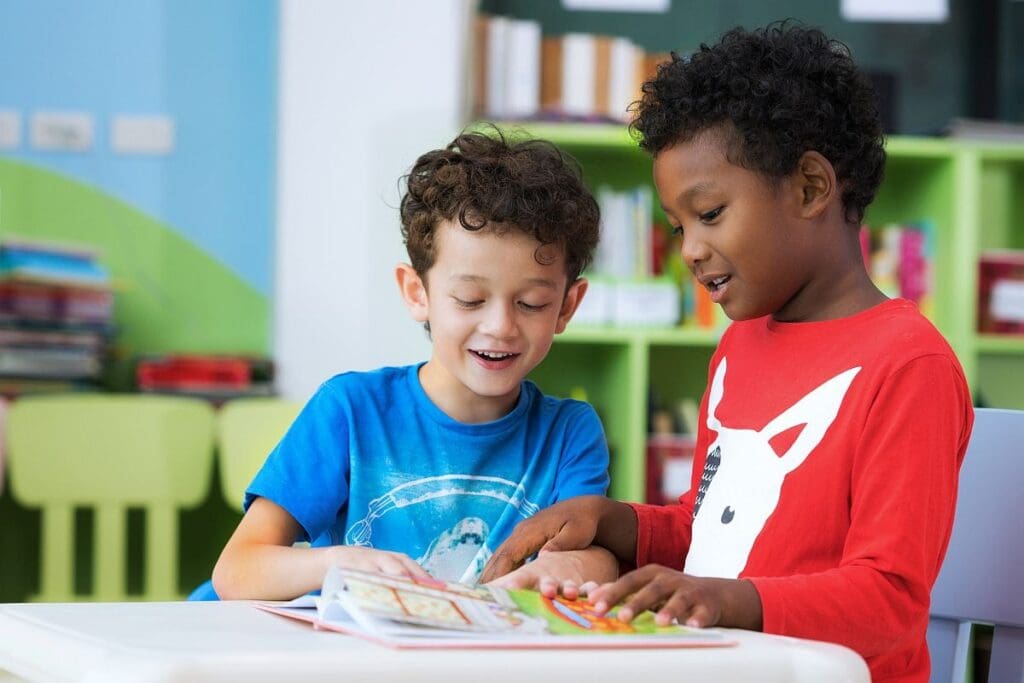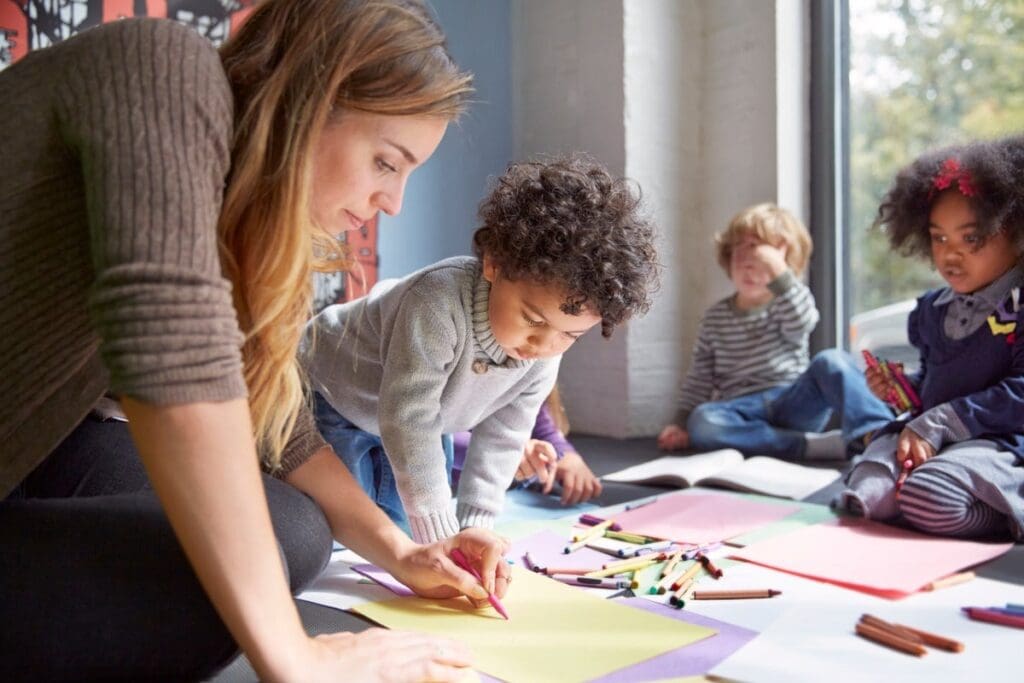Last Updated on November 24, 2025 by
We know how key it is to spot developmental strengths and challenges early on. Early childhood assessment tools are special methods. They help teachers check on young kids’ growth in areas like language, thinking, social skills, and movement.

Developmental screening tools give a quick look at how a child is doing. They help teachers spot if a child might be falling behind. With the right tools, we can act fast and tailor learning to each child’s needs. This helps both teachers and families help every child grow.
As educators and caregivers, we use early childhood assessments to learn about a child’s strengths and areas for growth. This process involves collecting information about a child’s development and learning.

Early childhood assessment uses various tools and methods to check a child’s progress. The National Association for the Education of Young Children (NAEYC) says it helps us understand a child’s development and learning.
“Assessment is not just about evaluating children; it’s about understanding how to support their development,” says the prestigious Children’s Association. This approach helps teachers tailor their teaching to meet each child’s needs. It makes learning better for the child.
Early childhood assessment is very important. It helps find developmental delays or challenges early. Early intervention can significantly impact a child’s developmental trajectory, ensuring they get the support they need.
Assessment results also help create learning environments that support a child’s growth. This includes their social-emotional, cognitive, and physical development. By using developmental assessments and preschool assessment tools, educators can understand a child’s abilities and challenges well.
In conclusion, early childhood assessment is a key part of a child’s education. By understanding its role, we can better support young children’s development.
Checking a child’s growth requires a look at many areas. Tests are made to check on language, thinking, social skills, and physical abilities.
Language skills help kids talk and share their needs. Tests check if they can hear sounds, know words, and follow directions. For example, the Ages and Stages Questionnaire (ASQ-3) sees if they can understand and answer when called.
Key areas assessed include:
Cognitive skills help kids think, learn, and solve problems. Tools like the BRIGANCE Early Childhood Screens check if they can spot shapes, count, and grasp simple ideas.
Key cognitive skills assessed include:
Social skills are key for making friends and handling feelings. Tests see if kids can work with others, share feelings, and care for friends.

Physical skills let kids play and explore. Tests check if they can run, jump, and handle things.
Key physical and motor skills assessed include:
Screening tools are key in early childhood education. They help teachers give focused help and support. The right tool depends on the child’s age, where they learn, and what they’re learning.
Observation checklists are a common screening tool in early childhood education. Teachers watch how children behave and check if they show certain skills. This way, they see how kids do things in their daily lives.
These checklists are great for checking on social and emotional skills and physical abilities. They work well in classrooms and playgrounds, making them a good preschool screener.
Structured questionnaires are another screening tool used in early childhood education. They ask parents or caregivers about their child’s growth, actions, and achievements. They can be on paper, online, or in interviews.
These questionnaires help gather information on a child’s growth in different places. They check on language, thinking, and social and emotional skills.
Performance-based assessments ask kids to do specific tasks to show their skills. They check on thinking, language, and physical skills. They give a clear view of what kids can do well and what they need help with.
Many screening tools, like these assessments, come in languages like English and Spanish. This makes them useful for kids from different backgrounds. The “Birth to 5: Watch Me Thrive: A Compendium of Screening Measures for Young Children” highlights this benefit.
Checking how children develop is key, and tools like ASQ-3, BRIGANCE, and KSA are vital for teachers. They spot where kids might need extra help, so they can get the right support.
The Ages and Stages Questionnaire (ASQ-3) is a top choice for checking kids from 1 month to 66 months. It looks at communication, movement, fine motor skills, problem-solving, and social skills. It’s easy to use and lets parents help with the test.
Parents fill out the ASQ-3, making it affordable and easy for them. It has 30 questions across five areas. It finds developmental delays early, so kids can get help fast.
BRIGANCE Early Childhood Screens are used for kids from birth to kindergarten. They check language, motor skills, and thinking abilities. This gives a full picture of a child’s growth.
The BRIGANCE screens are reliable and valid, trusted by teachers. They come in English and Spanish, helping in different schools.
The Kindergarten Screening Assessment (KSA) is for kids starting kindergarten. It looks at language, math, and social skills. It shows if a child is ready for school.
The KSA gives teachers a quick look at a child’s school readiness. It’s given at the start of kindergarten. It helps find where a child might need extra help.
In short, tools like ASQ-3, BRIGANCE, and KSA give deep insights into child growth. By knowing what these standardized preschool assessments do, teachers can help kids grow and learn better.
Using screening tools in early childhood education is more than just tests. It’s about helping children grow. We need to think about many things to make sure the screening helps the kids.
For example, early literacy screening tools should be given out many times during the school year. This is what the Early Literacy Screening Tools Resource says. It helps us see how kids are doing and if they need extra help.
It’s important to give these tests at the right time. This makes sure the results are true and show where the child is in their development.
To do these tests right, we need to follow some key steps. We should make sure the people giving the tests are trained. Also, the place where the test is given should be comfortable for the child.
“The quality of the assessment environment can significantly impact the child’s performance and the accuracy of the screening results.”
Also, we must keep the test process the same as the manual says. This keeps the test fair and reliable.
Understanding the test results is important. We need to know about child development and the test we’re using. The results should help us teach better and support kids who need it.
It’s not just about finding out if a child is behind; it’s about using that info to help them learn and grow.
By following these steps and best practices, we can make sure screening tools really help young children grow and learn.
Reliability and validity are key in early childhood education. We use these tools to spot kids who might need extra help. These tools must give us accurate and dependable results.
To make sure these tools work well, we need to look at the research. Studies have checked how different tools perform. This gives us important information.
Research is essential for proving if tools are reliable and valid. Some tools, like the Ages and Stages Questionnaire (ASQ-3) and the BRIGANCE Early Childhood Screens, are good.
A study in the Journal of Early Childhood Research found the ASQ-3 is reliable and valid. It’s great for tracking kids’ growth (α = 0.85). The BRIGANCE Early Childhood Screens also do well in spotting kids at risk for delays.
A 2023 study by Ohio State University looked at the Kindergarten Screening Assessment (KSA). It found the KSA is very reliable (α = 0.96) and good at checking if kids are ready for kindergarten.
This study’s results are very important. They show how using good screening tools helps teachers find kids who need extra help. This way, teachers can give them the support they need to do well.
In conclusion, the reliability and validity of screening tools are very important. By using research to guide us, we can offer the best support to young children and their families.
Screening tools are key in early childhood education. They help teachers spot developmental delays early. This way, they can act fast and give the right help.
These tools help find delays early, leading to better support and learning plans. Using good screening tools means kids get the help they need to grow well.
In summary, tools for early development are very important. They help young children learn and grow. By using these tools well, we can really help kids and their families.
Screening tools help check a child’s growth in areas like language, thinking, feelings, and movement. They spot any delays early. This helps teachers give each child the right help and lessons.
Screening tools look at a child’s language, thinking, feelings, and physical skills. These are the main areas they check.
There are different tools like checklists, questionnaires, and tests. Each has its own way of checking a child’s progress.
Tools like the Ages and Stages Questionnaire (ASQ-3) and the BRIGANCE Early Childhood Screens are common. They help teachers understand how children are doing.
How often depends on the tool and the children’s needs. Usually, they are used at the start of school or at certain ages.
It’s best to have trained people do the tests. Make sure the kids feel comfortable. Use the tools at the right time for the best results.
The results show where kids might need extra help. This helps teachers plan special lessons to support their growth.
Reliable tools give accurate results. This helps teachers make good plans for each child. Research backs up the use of these tools.
Tools like the BRIGANCE Early Childhood Screens are key. They help check how kids are doing and spot any issues early.
Tests like the ASQ-3 check kids in areas like language, thinking, feelings, and movement. They help find any delays or problems.
These tools are important. They give a full picture of a child’s growth. This helps teachers plan the right help and lessons for each child.
Subscribe to our e-newsletter to stay informed about the latest innovations in the world of health and exclusive offers!